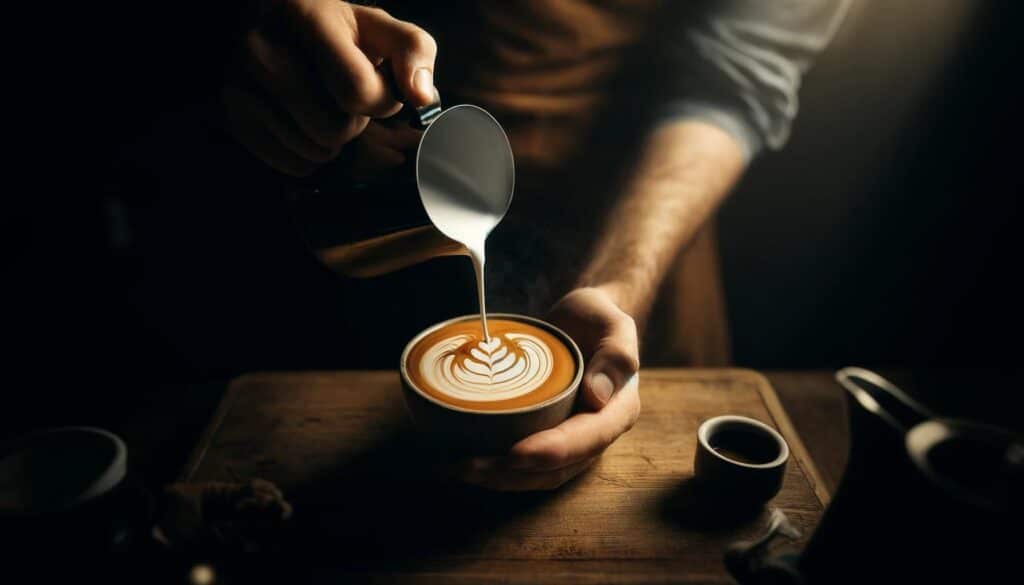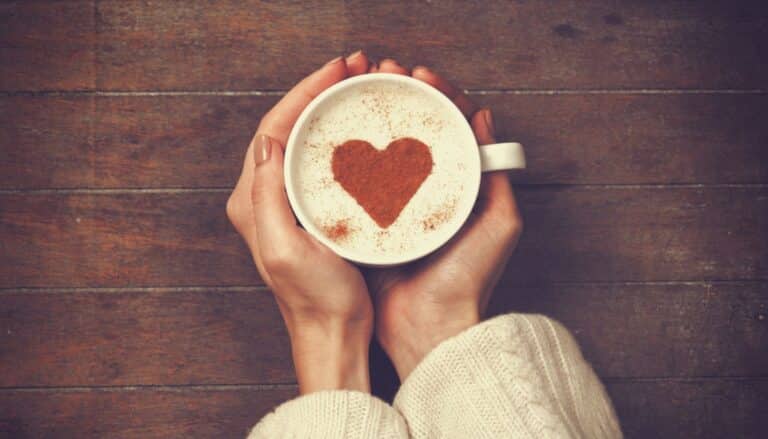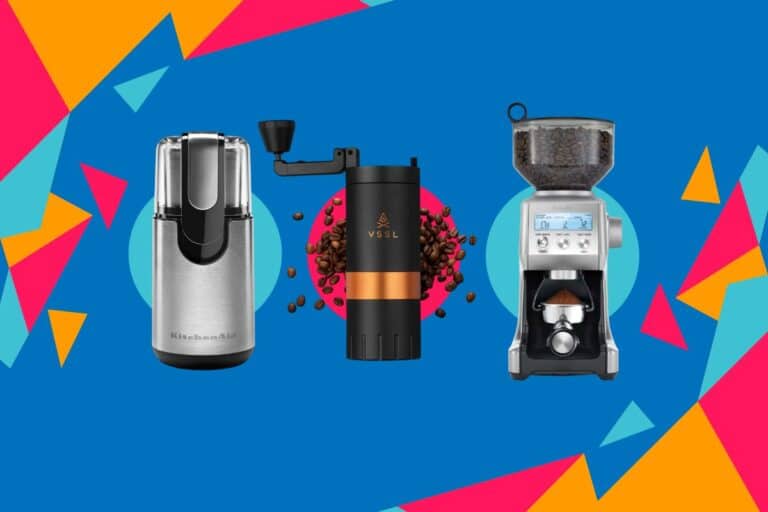The Flat White, that smooth little number that’s been sneaking its way into coffee menus all over the planet, really tells you something about how we’ve all gotten a bit fancier with our coffee choices. Its backstory? Well, it’s kind of like a mystery novel with a bit of friendly rivalry thrown in for good measure, giving us a peek into how coffee isn’t just a drink—it’s a whole vibe.
What is a Flat White Coffee?
A Flat White is a coffee drink that originated from Australia and/or New Zealand. It’s prepared by pouring microfoam (steamed milk from the bottom of a pitcher) over a single or double shot of espresso. The result is a velvety and smooth coffee with a strong espresso flavor, slightly milder than a latte due to the texture of the milk and typically served in a smaller cup.
Brief History of the Flat White
So, here’s the scoop on the Flat White: Australia and New Zealand are both trying to pin a medal on their chests for inventing it back in the 80s. In Australia, they say the Flat White came to be because folks were over the super frothy cappuccinos and wanted something silkier, more chill. Across the ditch in New Zealand, they reckon it was first whipped up in Auckland, quickly becoming the cool kid of the coffee scene before jet-setting around the globe. Wherever it really came from, one thing’s for sure—the Flat White’s got roots in a coffee revolution, showing off how much we’ve started to care about a quality brew and the art of milk that’s just so.
Its Origin and Popularization Across Different Regions
Then, this Aussie-Kiwi gem started to globe-trot, especially hitting it big in the UK in the early 2000s. People there fell hard for its bold espresso heart wrapped in a cozy milk hug—a sweet spot between the airy cappuccino and the milk-forward latte. Cafes from London to Edinburgh began to serve up the Flat White as the new kid on the block, and coffee lovers were here for it.
When the Flat White hopped over to the US, it was like, “Hey, try this on for size.” Americans, used to their big, milky coffees, got a taste of something more focused, more about the flavor. It wasn’t long before you could spot Flat Whites on the menu in both the cool, indie coffee spots and the big-name chains, marking its spot in the coffee hall of fame.
Nowadays, the Flat White’s got fans all over the world, cherished for its perfect harmony of strong coffee and smooth milk. It’s a sign of how far we’ve come with our coffee game—from a quick caffeine fix to savoring each sip. Its journey across oceans and borders just goes to show that coffee is something we all get, something that brings us together in our quest for that ideal cup.
Defining the Flat White

The Flat White has carved out a niche for itself in the world of coffee, offering a distinct experience that hinges on its composition and the skill involved in its creation. Understanding what sets it apart from other espresso-based drinks requires a dive into its basic components and a comparison with its coffee cousins, the Latte and Cappuccino.
The Basic Components of a Flat White
A Flat White is essentially made of two key ingredients: espresso and steamed milk. The drink typically starts with a double shot of espresso, providing a robust coffee base. The milk, which is steamed to create a smooth, velvety microfoam, is then poured over the espresso. The hallmark of a Flat White is this microfoam, which is finer and silkier than the froth found on top of other coffee drinks. The ratio of coffee to milk in a Flat White is crucial; it generally leans towards a higher concentration of coffee, allowing the espresso’s flavors to be prominent, yet perfectly harmonized with the creamy texture of the milk. The result is a rich, full-flavored coffee with a smooth, luxurious mouthfeel.
Comparison with Similar Coffee Drinks (Latte, Cappuccino)
To understand the uniqueness of the Flat White, it’s helpful to compare it with the Latte and Cappuccino, two other popular milk-based espresso drinks:
- Latte: A Latte is made with a shot of espresso and a larger amount of steamed milk than a Flat White, topped with a light layer of milk foam. Lattes have a higher milk-to-coffee ratio, which makes them creamier and less intense in coffee flavor compared to a Flat White. The focus in a Latte is more on the smooth blend of milk and coffee rather than the strong coffee taste.
- Cappuccino: A Cappuccino consists of equal parts espresso, steamed milk, and milk foam, creating a layered drink. The significant difference here is the greater volume of foam, which gives Cappuccinos a lighter texture and a more pronounced milk flavor. Compared to a Flat White, a Cappuccino is less creamy and has a more airy foam on top, making it distinctly different in both taste and texture.
The Flat White distinguishes itself with its focus on showcasing the espresso’s flavor, supported by the creamy yet not overpowering presence of milk. It strikes a delicate balance, offering a coffee-centric drink that’s both rich and smooth without the dominance of milk foam or the diluted taste of excessive milk. This unique composition has made the Flat White a favorite among coffee enthusiasts who appreciate the subtle art of coffee making and the nuanced flavors it brings out.
The Art of Making a Flat White

Creating a Flat White is considered an art form, requiring precision and skill to perfectly balance the robust flavors of espresso with the creamy smoothness of milk. Each step, from selecting the coffee beans to pouring the milk, plays a crucial role in crafting a drink that stands out for its depth and harmony of flavors.
The Importance of Coffee Beans and Roast Level
The choice of coffee beans is fundamental in defining the character of a Flat White. Typically, beans with a medium to dark roast are preferred because they produce a strong, rich espresso base without the acidity that might come from lighter roasts. The roast level also influences the espresso’s body and crema, both of which are crucial for the drink’s overall texture and taste. Specialty coffee beans, known for their quality and unique flavor profiles, are often chosen to add complexity to the drink, enhancing its distinctiveness.
Grinding for the Perfect Espresso Shot
The grind size of the coffee beans is pivotal in achieving the optimal extraction for a Flat White’s espresso shot. A fine grind is generally recommended to create a shot that is intense and full-bodied, yet not bitter. The goal is to extract the rich flavors and aromatic oils without over-extracting, which can lead to a harsh taste. Precision in grinding ensures that the espresso forms a harmonious base for the drink, providing the depth and intensity that Flat White enthusiasts cherish.
The Role of Milk: Texture and Temperature
Milk in a Flat White is not just an additive; it is a central component that requires careful handling to achieve the desired texture and temperature. The milk should be steamed to create microfoam, which is finer and more integrated than the foam on a cappuccino. This microfoam should have the consistency of wet paint, allowing it to blend seamlessly with the espresso. Temperature is also key; milk that is too hot can scald and lose its sweetness, while milk that is not hot enough won’t create the right texture or warmth. The ideal temperature for steamed milk in a Flat White is around 60-65°C (140-149°F), which preserves the milk’s natural sweetness and enhances its creamy texture.
Technique for Steaming and Pouring Milk
The technique for steaming and pouring milk is what ultimately defines the presentation and mouthfeel of a Flat White. Steaming the milk to the right consistency requires a steady hand and an attentive ear, listening for the subtle cues that indicate when the milk has reached its perfect texture. Pouring the milk requires a precise technique, integrating the microfoam with the espresso in a way that highlights the coffee’s flavor while maintaining a smooth, velvety consistency. The pour starts high to allow the milk to dive underneath the espresso, then moves closer to the surface to create the signature white dot or pattern on top. This careful process ensures that each sip of a Flat White offers a perfect blend of strong espresso and creamy milk, making it a true art form in the world of coffee.
Variations Around the World

The Flat White, with its origins deeply rooted in Australasian coffee culture, has traveled far and wide, adopting subtle nuances that reflect the tastes and traditions of the places it has called home. These regional differences in preparation and presentation not only highlight the versatility of the drink but also how a simple coffee can be reinterpreted around the world.
Regional Differences in Preparation and Presentation
Australia and New Zealand: In its birthplace, the Flat White is typically served in a smaller, 150-160 ml ceramic cup. The emphasis is on creating a strong coffee flavor with a velvety texture, using a double shot of espresso and steamed milk with microfoam. The presentation is minimalist, often featuring a simple latte art design, such as a heart or rosetta.
United Kingdom: The UK’s adoption of the Flat White has seen it served in slightly larger cups than in Australia and New Zealand, sometimes up to 180 ml. The UK version maintains the creamy microfoam characteristic but may feature a slightly more pronounced presence of milk. British coffee shops, especially in cosmopolitan areas like London, have embraced elaborate latte art, making the Flat White as much a visual treat as a delicious one.
United States: The American interpretation of the Flat White tends to come in a variety of sizes, reflecting the US preference for larger beverage portions. Despite the larger size, specialty coffee shops strive to keep the coffee-to-milk ratio balanced to preserve the drink’s signature intensity. The use of different espresso blends, including single-origin beans, adds a unique twist to the flavor profile of the American Flat White.
Notable Variations and What Makes Them Unique
The “Strong Flat White”: In response to customers who desire an even bolder coffee flavor, some cafes offer a “Strong Flat White,” which includes an additional shot of espresso. This variation caters to those who prefer their coffee with a more pronounced espresso kick.
The “Magic”: A variation that is rumored to have originated in Melbourne, the “Magic” is a double ristretto Flat White, served in a smaller, 150 ml cup. The use of ristretto shots (a very short espresso shot) makes for a richer, sweeter coffee base, highlighting the espresso’s complex flavors without bitterness.
Dairy-Free Flat White: With the rise of dietary preferences and allergies, many cafes now offer dairy-free versions of the Flat White, using almond, soy, oat, or coconut milk. These alternatives not only cater to those with dietary restrictions but also introduce new flavor profiles, with each type of milk adding its own unique taste and texture to the drink.
Iced Flat White: In warmer climates or during summer months, the Iced Flat White has emerged as a popular variation. This version is prepared with cold milk and ice, providing a refreshing twist on the classic while still focusing on the coffee’s flavor.
These variations of the Flat White demonstrate its adaptability and the role of local preferences in shaping global coffee culture. Whether sticking to the traditional recipe or exploring new interpretations, the essence of the Flat White remains—a celebration of quality espresso harmoniously blended with creamy milk.
How to Enjoy a Flat White

Enjoying a Flat White goes beyond the mere act of drinking coffee; it’s about savoring a moment, whether that’s a quiet pause in a busy day or a leisurely catch-up with friends. The setting, time, and what you pair with your Flat White can elevate the experience, making each sip a cherished ritual.
Ideal Settings and Times for Savoring a Flat White
Morning Ritual: A Flat White can be a perfect start to the day, offering a balanced blend of robust espresso and smooth milk to awaken the senses. Enjoying it in the quiet of the morning, perhaps with a book or newspaper, can set a positive tone for the day ahead.
Mid-Morning Break: As the day picks up pace, a mid-morning Flat White can provide a much-needed pause. A café with a relaxed atmosphere, offering a view of the bustling city or a tranquil garden, makes for an ideal setting to take a moment for yourself.
Afternoon Catch-Up: The smooth, creamy nature of a Flat White makes it an excellent choice for an afternoon coffee meeting or catch-up with friends. A café with comfortable seating and a welcoming ambiance can foster engaging conversations over your coffee.
Post-Dinner Digestif: While not traditionally seen as a digestif, a Flat White can serve as a gentle conclusion to an evening meal, especially if you prefer coffee over sweet desserts. Enjoying it in a quiet, cozy spot can help you unwind and reflect on the day.
Pairing Suggestions: Best Foods to Accompany Your Coffee
Breakfast Options: A Flat White pairs beautifully with breakfast dishes that balance its richness without overpowering its flavor. Think avocado toast, a classic croissant, or a light fruit pastry. The creamy texture of the coffee complements both the savory and the sweet, enhancing the flavors of your meal.
Brunch Delights: For a late morning indulgence, pair your Flat White with eggs benedict, a spinach and feta quiche, or banana bread. The coffee’s robust character stands up well to the hearty flavors of brunch dishes, creating a satisfying flavor experience.
Afternoon Snacks: When enjoying a Flat White in the afternoon, opt for light snacks like almond croissants, madeleines, or a slice of carrot cake. The coffee’s creamy smoothness is a delightful contrast to the sweetness of these treats, making for a perfect midday treat.
Dessert Pairings: For those who prefer their coffee after dinner, a Flat White can beautifully accompany dessert choices like tiramisu, chocolate lava cake, or a simple dark chocolate square. The intensity of the espresso complements the richness of the chocolate, offering a sophisticated flavor pairing.
Whether you’re starting your day or taking a moment to relax, a Flat White can be the centerpiece of a delightful culinary experience. The key is to choose pairings and settings that complement the coffee’s unique balance of strength and creaminess, creating moments of pleasure and relaxation that enrich your day.
Making a Flat White at Home

Crafting a professional-grade Flat White at home is an achievable feat that can turn your coffee routine into an artisanal experience. With the right equipment, a bit of practice, and insider tips from seasoned baristas, you can enjoy a café-quality Flat White without stepping outside your door.
Equipment Needed to Make a Professional-Grade Flat White
- Espresso Machine: A good quality espresso machine with a steam wand is crucial for making both the espresso shot and steaming the milk to achieve the desired microfoam.
- Coffee Grinder: A burr grinder is preferred for grinding coffee beans to a uniform size, essential for a consistent and flavorful espresso extraction.
- Fresh Coffee Beans: Opt for high-quality, freshly roasted beans to ensure the espresso’s flavor is rich and robust.
- Milk Jug: A stainless steel milk jug with a spout is needed for steaming and pouring the milk.
- Thermometer: To monitor the milk’s temperature while steaming, ensuring it doesn’t scald.
- Tamper: For evenly pressing the ground coffee in the portafilter, which is key to a balanced extraction.
- Scales: Precision in coffee-to-water ratio is vital for the perfect espresso shot.
Step-by-Step Guide to Crafting the Perfect Cup
- Grind Your Coffee: Aim for a fine grind that resembles table salt. You’ll need about 18-20 grams of coffee for a double shot of espresso.
- Tamp the Grounds: Place the coffee in the portafilter and use the tamper to press down firmly and evenly, ensuring the surface is level.
- Brew the Espresso: Lock the portafilter in place and start the espresso machine. A good espresso shot should take about 25-30 seconds to pour.
- Steam the Milk: Fill your milk jug about half full with fresh milk. Submerge the steam wand just below the surface of the milk, and steam until the milk reaches a silky texture and a temperature of about 60-65°C (140-149°F).
- Combine Milk and Espresso: Pour the steamed milk into the espresso from a low height for a smooth integration, then raise the jug for the last part of the pour to create a dot or pattern on the surface.
Tips and Tricks from Baristas
- Use Fresh Milk: Fresh milk not only steams better but also contributes to a richer, creamier texture.
- Practice Milk Pouring: The pouring technique is crucial for achieving the signature Flat White look and texture. Practice pouring milk to create a smooth, even surface with minimal foam.
- Experiment with Coffee: Try different bean varieties and roasts to find your preferred flavor profile for a Flat White.
- Clean Your Equipment: Always clean your espresso machine and steam wand after use to ensure the best taste and prevent equipment issues.
- Be Patient: Mastering the art of the perfect Flat White takes practice, especially when it comes to milk texturing and pouring. Don’t be discouraged by initial attempts; each cup is a step towards perfection.
By following these steps and tips, you’ll be well on your way to enjoying a beautiful, barista-quality Flat White in the comfort of your own home. It’s a rewarding skill that not only elevates your coffee game but also adds a touch of café charm to your daily routine.
Conclusion
The Flat White isn’t just another coffee on the menu; it’s like the cool, globe-trotting friend who’s got stories to tell, changing the coffee game from our sleepy morning fix to a worldwide taste sensation. Its voyage from the cozy cafes of Australia and New Zealand all the way to the swanky coffee spots across the globe is pretty much a love letter to how we’ve all become a bit more adventurous with our coffee choices. With its dreamy mix of espresso and silky microfoam, the Flat White hasn’t just captured our hearts; it’s got us all chatting over the fence about what takes a coffee from just okay to absolutely stellar.
The Cultural Significance of the Flat White Coffee
When we talk about the Flat White’s place in the coffee world, we’re really diving into how coffee’s gone from zero to hero in the craft department. This little drink is at the forefront of the coffee scene’s dive into artisan vibes, where every sip is about quality, care, and a dash of creativity. It’s not just about mixing coffee and milk; it’s an art form, pushing baristas to show off their skills and coffee lovers to really think about what makes their cup so good. It’s a nod to the craftsmanship that goes into every pour, turning baristas into coffee celebs in their own right.
But that’s not all—the Flat White’s claim to fame has sparked this epic coffee convo that spans the globe, knitting together different coffee cultures with its creamy, caffeinated goodness. It’s like a handshake between the coffee traditions of Australasia, known for being super picky and innovative with their brews, and coffee enthusiasts everywhere else, eager to sip on something new. This back-and-forth of ideas and techniques isn’t just cool; it’s what keeps the coffee community buzzing, driving us towards that perfect cup with every shot pulled and every milk steamed. It’s about sharing a passion, one Flat White at a time.
Encouragement to Explore and Enjoy the Flat White Coffee
If you’ve never had a Flat White, you’re in for a real treat. This coffee isn’t just a drink; it’s like an adventure for your taste buds, inviting you to dive deep into the dance between coffee and milk. It doesn’t matter if you’re a coffee expert or just starting to explore the world of java, the Flat White is like a warm welcome into the art of coffee crafting and the vibrant culture that surrounds it.
Picture yourself playing around with different coffee beans, roasts, and even types of milk. Each choice brings out a new side of the Flat White, turning every cup into a discovery. Plus, getting into making this drink at home isn’t just about leveling up your barista game; it’s about putting your own spin on your coffee routine, making each sip a little celebration of your effort and creativity.
To wrap it up, the Flat White is so much more than your average cup of coffee. It’s like a bridge between cultures, a spotlight on the skills of amazing baristas, and a call to all of us looking for something truly special in our coffee mug. As it continues to win over folks everywhere, the Flat White stands as a shining example of coffee’s ability to inspire and connect us. So, consider this your nudge to get out there, try it, and dive into the rich, creamy world of the Flat White. Let it surprise you, teach you, and become a beloved part of your coffee-loving heart.
FAQs about the Flat White
What is the caffeine content of a Flat White?
The caffeine content in a Flat White largely depends on the coffee beans used and the size of the espresso shot. Typically, a Flat White is made with a double shot of espresso, which can contain approximately 120 to 130 milligrams of caffeine. This makes it slightly stronger than a standard latte or cappuccino due to its higher espresso to milk ratio.
Can I use milk alternatives in a Flat White?
Yes, milk alternatives can be used to make a Flat White. Soy, almond, oat, and coconut milk are popular choices for those avoiding dairy or seeking a different flavor profile. However, the texture and taste will vary depending on the type of milk used. Some milk alternatives are better at creating the silky microfoam characteristic of a Flat White, with oat milk being a particularly good option due to its creaminess and ability to foam.
How does a Flat White differ from a latte?
The main difference between a Flat White and a latte lies in the milk to coffee ratio and the texture of the milk. A Flat White typically has a higher concentration of coffee and uses microfoam (steamed milk with fine, velvety bubbles) which results in a richer coffee flavor and a smoother texture. Lattes have more steamed milk and a light layer of foam on top, making them milkier and lighter in coffee flavor compared to a Flat White.
Is a Flat White stronger than a cappuccino?
In terms of coffee flavor intensity, a Flat White can be considered stronger than a cappuccino due to its higher ratio of espresso to milk. Cappuccinos have equal parts of espresso, steamed milk, and foam, which dilutes the coffee flavor more than in a Flat White. However, in terms of caffeine content, both drinks are similar if made with the same amount of espresso shots.
What is the best time of day to enjoy a Flat White?
A Flat White can be enjoyed at any time of the day, depending on personal preference. It is popular as a morning coffee due to its robust flavor and creamy texture, providing a satisfying start to the day. However, its balanced nature also makes it a great choice for an afternoon pick-me-up.
How important is the quality of the espresso in a Flat White?
The quality of the espresso is crucial in a Flat White, as it forms the backbone of the drink’s flavor. A high-quality, well-extracted espresso shot provides the rich and robust taste that is characteristic of a good Flat White. The choice of coffee beans and the precision of the brewing process directly impact the overall taste, making it essential to use fresh beans and a proper espresso machine for the best results.







1 thought on “What is a Flat White Coffee?”
Pingback: How to Make a Flat White Coffee - Alpine Mountain Coffee